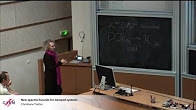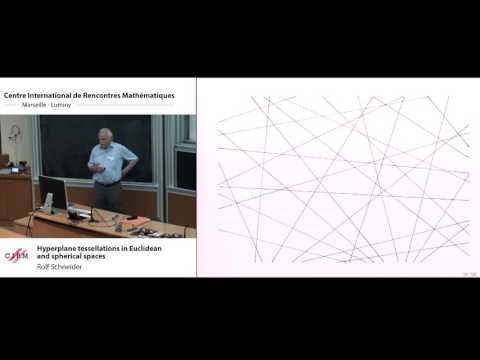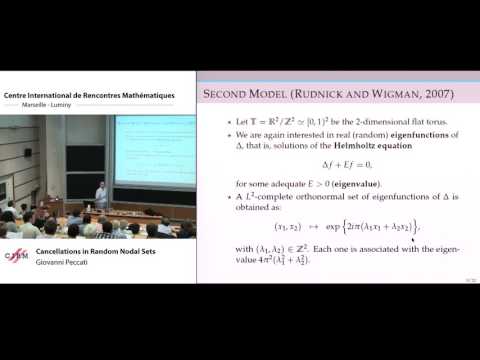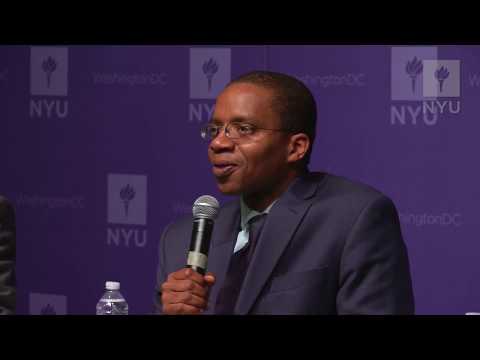source:
Centre International de Rencontres Mathématiques

38:22
Christiane Tretter: New spectral bounds for damped systems Abstract: In this talk new enclosures for the spectra of operators associated with second order Cauchy problems are presented for non-selfadjoint damping. Our new results yield much better bounds t...

41:34
Cristina Câmara: Truncated Toeplitz operators Abstract: Toeplitz matrices and operators constitute one of the most important and widely studied classes of non-self-adjoint operators. In this talk we consider truncated Toeplitz operators, a nat...

45:05
Anne Sophie Bonnet-Ben Dhia: A new complex spectrum associated to invisibility in waveguides Abstract: We consider an acoustic waveguide modeled as follows:
{Δu+k2(1+V)u=0∂u∂y=0inonΩ=ℝ×]0,1[∂Ω
where u denotes the complex valued pressure, k is the frequency and V∈L∞(Ω) is a compactly supp...

42:05
Bernard Helffer: Spectral theory and semi-classical analysis for the complex Schrödinger operator Abstract: We consider the operator Ah=−h2Δ+iV in the semi-classical limit h→0, where V is a smooth real potential with no critical points. We obtain both the left margin of the spectrum, as well as...

43:07
Eva Gallardo Gutiérrez: The invariant subspace problem: a concrete operator theory approach Abstract: The Invariant Subspace Problem for (separable) Hilbert spaces is a long-standing open question that traces back to Jonhn Von Neumann's works in the fifties asking, in particular, if every...

53:12
Tom Spencer: Introduction to hyperbolic sigma models and Edge Reinforced Random Walk Abstract: This talk will introduce two statistical mechanics models on the lattice. The spins in these models have a hyperbolic symmetry. Correlations for these models can be expressed in terms of ...

59:00
Yuval Peres: Self-interacting walks and uniform spanning forests Abstract: In the first half of the talk, I will survey results and open problems on transience of self-interacting martingales. In particular, I will describe joint works with S. Popov, P. Sousi, R...

52:00
Takashi Kumagai: Time changes of stochastic processes: convergence and heat kernel estimates Abstract: In recent years, interest in time changes of stochastic processes according to irregular measures has arisen from various sources. Fundamental examples of such time-changed processes incl...

4:29
Martin Hairer ITV Behind the scenes Martin Hairer, Fields Medalist 2014 : interview behind the scenes...
Currently Regius Professor of Mathematics at the Mathematics Department of The University of Warwick.
Martin Hairer KBE FRS (b...

19:36
Interview at Cirm: Martin Hairer Interview at Cirm: Martin Hairer, Fields Medalist 2014
Currently Regius Professor of Mathematics at the Mathematics Department of The University of Warwick.
Martin Hairer KBE FRS (born 14 November...

49:39
James Maynard: Large gaps between primes in subsets Abstract: All previous methods of showing the existence of large gaps between primes have relied on the fact that smooth numbers are unusually sparse. This feature of the argument does not seem to ...

41:56
Anne de Roton: Small sumsets in continuous and discrete settings Abstract : Given a subset A of an additive group, how small can the sumset A+A={a+a′:a,a′ϵ A} be ? And what can be said about the structure of A when A+A is very close to the smallest possible size...

42:14
Zeev Rudnick: Angles of Gaussian primes Abstract: Fermat showed that every prime p=1 mod 4 is a sum of two squares: p=a2+b2, and hence such a prime gives rise to an angle whose tangent is the ratio b/a. Hecke showed, in 1919, that these ...

32:39
Sigrid Grepstad: Bounded remainder sets for the discrete and continuous irrational rotation Abstract : Let α ϵ ℝd be a vector whose entries α1,...,αd and 1 are linearly independent over the rationals. We say that S⊂𝕋d is a bounded remainder set for the sequence of irrational rotations {nα...

44:59
Youness Lamzouri: Large character sums Abstract : For a non-principal Dirichlet character χ modulo q, the classical Pólya-Vinogradov inequality asserts that
M(χ):=maxx|∑n≤xχ(n)|=O(q‾√log q).
This was improved to q‾√log log q by

39:31
Rolf Schneider: Hyperplane tessellations in Euclidean and spherical spaces Abstract: Random mosaics generated by stationary Poisson hyperplane processes in Euclidean space are a much studied object of Stochastic Geometry, and their typical cells or zero cells belong to th...

42:02
Martina Zähle: Curvature measures of random sets Abstract: A survey on some developments in curvature theory for random sets will be given. We first consider previous models with classical singularities like polyconvex sets or unions of sets with...

34:20
Adrian Baddeley: The Poisson-saddlepoint approximation Gibbs spatial point processes are important models in theoretical physics and in spatial statistics. After a brief survey of Gibbs point processes, we will present a method for approximating their ...

46:55
Jean-Michel Morel: Detection theory and novelty filters Abstract: In this presentation based on on-line demonstrations of algorithms and on the examination of several practical examples, I will reflect on the problem of modeling a detection task in imag...

43:04
Giovanni Peccati: Cancellations in random nodal sets Abstract: I will discuss second order results for the length of nodal sets and the number of phase singularities associated with Gaussian random Laplace eigenfunctions, both on compact manifolds (t...

45:32
Perla Sousi: Random walks on dynamical percolation Abstract: We study the behaviour of random walk on dynamical percolation. In this model, the edges of a graph are either open or closed and refresh their status at rate μ, while at the same time a ...

52:43

















































